Basic Styles of Hanfu
Hanfu is traditional Chinese clothing with a rich history and diverse styles. The basic styles of Hanfu primarily include the following three:
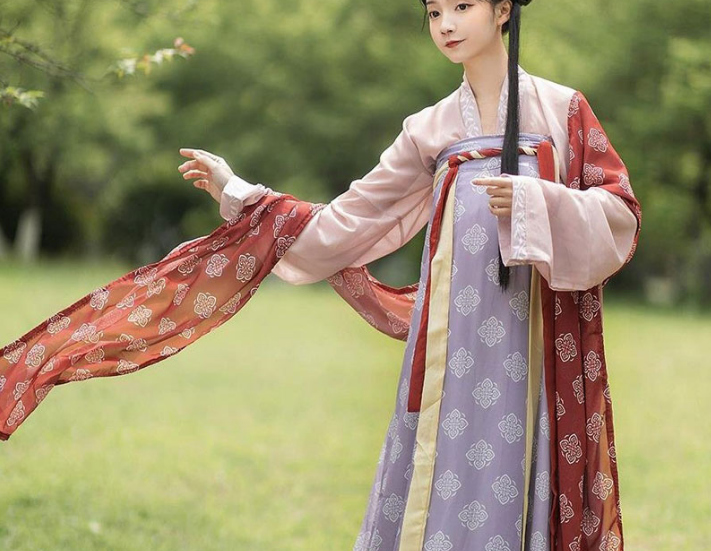
Ruqun
Ruqun (襦裙) is a traditional Hanfu outfit typically comprised of two parts: a top and a skirt. Here are some key features of Ruqun:
- Construction and Appearance: Ruqun generally consists of a short top worn over a longer skirt, revealing the skirt’s hem.
- Skirt Characteristics: The skirt is typically long and A-line shaped with pleats, providing a rich and flowing hem.
- Wearing Style: The top of the Ruqun is tied over the skirt and can feature different collar and sleeve designs.
- Occasions: Ruqun is commonly worn for formal occasions such as traditional festivals, weddings, and solemn ceremonies.
Aoqun
Aoqun (袄裙) is another common Hanfu style with its unique characteristics and style:
- Construction and Appearance: Aoqun consists of a top and a skirt, with the top being relatively longer, typically reaching the waist or hips.
- Top Features: The top can have a straight, crossed, or slanting collar design, often adorned with exquisite details at the collar and sleeves.
- Skirt Characteristics: The length and shape of the skirt may vary, but it maintains an elegant and comfortable look.
- Occasions: Aoqun is suitable for various formal and semi-formal occasions, offering practicality and style.
Pao
Pao (袍) is a long robe-style Hanfu with a range of features and applications:
- Construction and Appearance: Pao is a long robe, typically reaching the ankles, and it lacks separate top and skirt sections.
- Collar and Sleeves: The collar of Pao can be straight or crossed, while the sleeves are typically loose and flowing.
- Wearing Style: Pao can be fastened with ties or buttons, providing a unique wrapping sensation.
- Occasions: Pao is often reserved for significant formal events such as banquets, celebrations, and weddings.
These Hanfu styles each have their own distinct features and suitable occasions, reflecting the diversity and richness of traditional Chinese clothing. For more detailed information, you can click on the respective Wikipedia links provided.
Collar and Sleeve Designs in Hanfu
Hanfu, the traditional clothing of China, features various collar and sleeve designs that contribute to its unique aesthetics and functionality. Here, we explore some of these designs in detail:
Zhili (Straight Collar)
Zhili (直领) is a classic collar design in Hanfu, known for its simplicity and elegance:
- Construction: The Zhili collar is straight and upright, framing the neck and upper chest with clean lines.
- Historical Significance: Zhili collars were popular during the Han and Tang Dynasties and remain a symbol of traditional Chinese fashion.
- Applications: This collar design is often used for formal Hanfu outfits, providing a dignified and timeless appearance.
Learn more about Zhili collars
Xieling (Slanting Collar)
Xieling (斜领) is a slanted collar design in Hanfu, adding a touch of grace and sophistication:
- Construction: Xieling collars are slanted diagonally across the chest, creating an asymmetrical and visually appealing look.
- Historical Roots: This collar style has historical roots in the Ming and Qing Dynasties, showcasing the evolving Hanfu fashion over time.
- Versatility: Xieling collars are versatile and can be found in both formal and semi-formal Hanfu outfits, offering a blend of tradition and modernity.
Learn more about Xieling collars
Qixiongjin (Cross-collar)
Qixiongjin (齐胸襟), also known as cross-collar, is a distinctive feature in Hanfu with its cross-over design:
- Construction: Qixiongjin collars cross over the chest and are fastened with ties or buttons, forming an X-shaped pattern.
- Historical Influence: This collar style harks back to ancient Hanfu and is closely associated with traditional Chinese culture.
- Variations: Qixiongjin can be found in various Hanfu styles, ranging from elegant dresses to practical everyday wear.
Learn more about Qixiongjin collars
Kuanxiu (Wide Sleeves) and Zhaixiu (Narrow Sleeves)
Kuanxiu (宽袖) and Zhaixiu (窄袖) represent the diverse sleeve designs in Hanfu, each with its own unique characteristics:
- Kuanxiu (Wide Sleeves):
- Construction: Kuanxiu sleeves are loose and flowing, emphasizing comfort and freedom of movement.
- Historical Significance: These wide sleeves have been a hallmark of Hanfu throughout history, favored for their graceful appearance.
- Applications: Kuanxiu sleeves are commonly featured in formal and ceremonial Hanfu, adding a sense of grandeur and elegance.
- Zhaixiu (Narrow Sleeves):
- Construction: Zhaixiu sleeves are more fitted and narrow, providing a sleek and tailored look.
- Historical Roots: This sleeve style gained popularity during the Ming and Qing Dynasties, reflecting evolving fashion trends.
- Versatility: Zhaixiu sleeves are suitable for both traditional and modern Hanfu, offering a streamlined and contemporary appearance.
Learn more about Kuanxiu and Zhaixiu sleeves
These collar and sleeve designs are integral to Hanfu’s appeal, allowing wearers to express their individual style while honoring Chinese cultural traditions. For further information, you can click on the provided Wikipedia links.
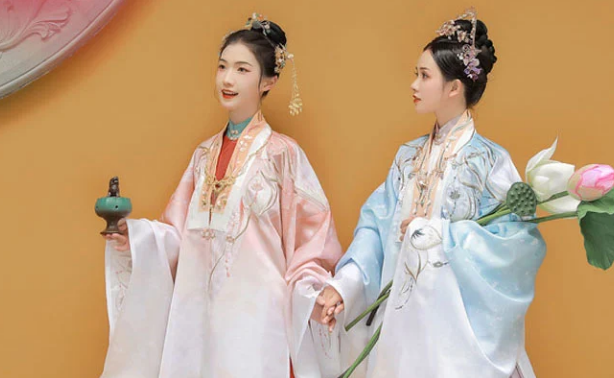
Skirt and Hem Styles in Hanfu
The skirt and hem styles in Hanfu play a crucial role in defining the overall look and feel of traditional Chinese clothing. Here, we explore various skirt and hem styles in detail:
Duijin (Straight Skirt)
Duijin (直裙) refers to the straight skirt style in Hanfu, known for its clean lines and timeless elegance:
- Construction: Duijin skirts have a straight and narrow silhouette that extends down to the ankles. They are often pleated for a graceful flow.
- Historical Influence: This skirt style has been a part of Hanfu fashion for centuries, offering a classic and understated appearance.
- Applications: Duijin skirts are commonly seen in both formal and semi-formal Hanfu outfits, representing a harmonious blend of tradition and modernity.
Learn more about Duijin skirts
Xiejv (Slanting Hem)
Xiejv (斜裾) is a slanting hem style in Hanfu, adding a touch of dynamic and artistic flair:
- Construction: Xiejv skirts feature a diagonal or slanting hemline that creates an asymmetrical and visually appealing effect.
- Historical Roots: This unique hem style gained popularity during the Ming and Qing Dynasties, symbolizing the evolution of Hanfu fashion.
- Versatility: Xiejv hems can be found in various Hanfu styles, offering a contemporary and stylish look with a hint of tradition.
Wanbai (Curved Hem)
Wanbai (弯摆) represents the curved hem style in Hanfu, celebrated for its graceful and flowing appearance:
- Construction: Wanbai skirts have a hemline that curves gently, creating a subtle and captivating swaying effect.
- Historical Significance: This hem style has its roots in ancient Hanfu, where it was embraced for its aesthetic appeal and fluid movement.
- Applications: Wanbai hems are often featured in formal Hanfu attire, particularly for ceremonies and special occasions, to exude elegance and poise.
Wadai (Hem Embroidery)
Wadai (袜底) involves the art of hem embroidery in Hanfu, adding intricate detailing and a touch of craftsmanship:
- Construction: Wadai features delicate embroidery along the hemline of Hanfu skirts, showcasing intricate patterns and motifs.
- Historical Roots: Hem embroidery has a rich history in Hanfu, serving as a symbol of status, artistry, and attention to detail.
- Versatility: This embellishment can be incorporated into various Hanfu styles, enhancing their overall visual appeal and cultural significance.
Learn more about Wadai embroidery
These skirt and hem styles in Hanfu exemplify the diversity and craftsmanship of traditional Chinese clothing. For further information, you can click on the provided Wikipedia links.
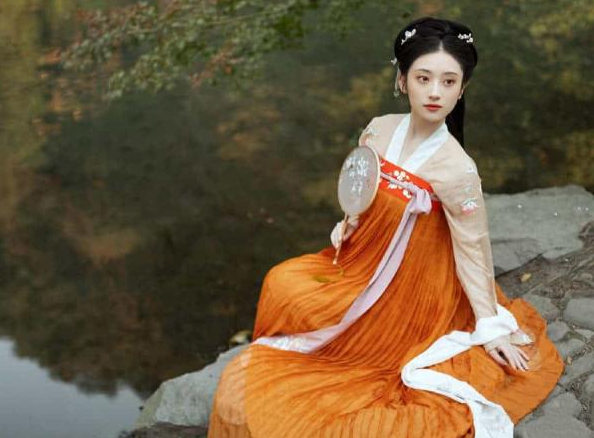
Colors and Patterns in Hanfu
The colors and patterns of Hanfu play a vital role in reflecting Chinese cultural heritage and aesthetic values. Let’s explore these elements in detail:
Traditional Hanfu Colors
Traditional Hanfu Colors encompass a rich palette deeply rooted in Chinese culture:
- Colors: Traditional Hanfu colors include classic shades like vermilion, sapphire blue, emerald green, and ink black.
- Symbolism: Each color holds symbolic significance, with red symbolizing joy and celebration, while black represents solemnity.
- Historical Context: These colors have been a part of Hanfu for centuries, reflecting cultural traditions and values.
Learn more about Traditional Hanfu Colors
Common Patterns and Motifs
Common Patterns and Motifs are an integral part of Hanfu design, each with its unique symbolism and significance:
- Patterns: Hanfu often features intricate patterns such as phoenixes, dragons, clouds, and flowers.
- Symbolism: These patterns hold deep cultural meanings, with dragons representing power and phoenixes symbolizing rebirth.
- Cultural Influence: The use of patterns in Hanfu reflects the fusion of art, history, and symbolism in Chinese clothing.
Learn more about Common Patterns and Motifs in Hanfu
Embroidery on Hanfu (Xiuhua)
Embroidery on Hanfu, known as Xiuhua (绣花), is a highly skilled craftsmanship that enhances the beauty of Hanfu:
- Technique: Xiuhua involves intricate embroidery using silk threads to create patterns and motifs on the fabric.
- Variety: Patterns can range from auspicious symbols to intricate landscapes, showcasing the diversity of Chinese embroidery.
- Historical Heritage: Xiuhua has a long history and is considered an art form, with different regions in China having their unique embroidery traditions.
Learn more about Embroidery on Hanfu (Xiuhua)
Colors, patterns, and embroidery in Hanfu contribute to its cultural depth and visual richness. For further information, you can click on the provided Wikipedia links.
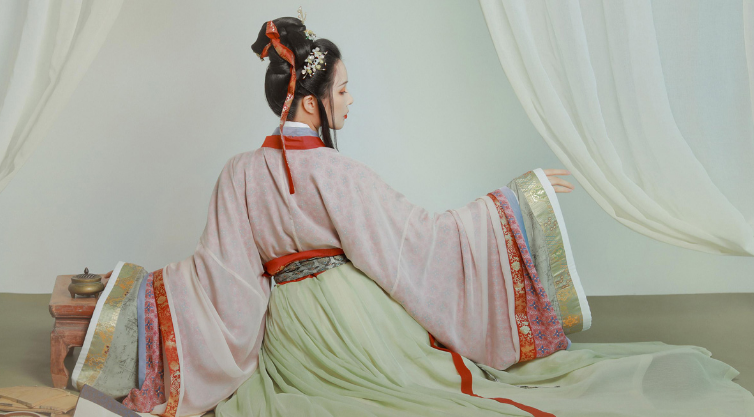
Accessories and Headwear in Hanfu
Accessories and headwear are essential components of Hanfu attire, adding elegance and cultural significance to the overall ensemble. Let’s delve into these elements in detail:
Yaodai (Waist Belts)
Yaodai (腰带) refers to waist belts in Hanfu, which serve both practical and aesthetic purposes:
- Design and Materials: Yaodai comes in various designs and materials, including silk, satin, and embroidered fabric.
- Function: These belts cinch the waist, accentuating the wearer’s figure and enhancing the overall silhouette of Hanfu.
- Cultural Significance: Yaodai often features intricate embroidery or patterns, reflecting cultural symbols and auspicious motifs.
Learn more about Yaodai (Waist Belts) in Hanfu
Faji (Hairpins)
Faji (发簪) are hairpins that adorn the hair of those wearing Hanfu, showcasing traditional craftsmanship:
- Variety: Faji comes in various styles and materials, from simple and elegant designs to elaborate and ornate ones.
- Usage: These hairpins serve both functional and decorative purposes, securing the hairstyle and adding a touch of beauty.
- Cultural Heritage: Faji often incorporates auspicious symbols and motifs, reflecting the rich cultural heritage of China.
Learn more about Faji (Hairpins) in Hanfu
Chaizi (Hair Ornaments)
Chaizi (钗子) represent hair ornaments that complete the look of Hanfu, contributing to its elegance:
- Design and Craftsmanship: Chaizi come in various forms, from simple hairpins to intricate hair combs adorned with gemstones and pearls.
- Adornment: These ornaments are carefully placed in the hair to secure it while adding a touch of sophistication.
- Cultural Significance: Chaizi often feature designs inspired by nature, such as flowers, birds, and other symbolic elements.
Learn more about Chaizi (Hair Ornaments) in Hanfu
Accessories and headwear in Hanfu are not only functional but also carry deep cultural significance, reflecting China’s rich heritage and artistic traditions. For further information, you can click on the provided Wikipedia links.
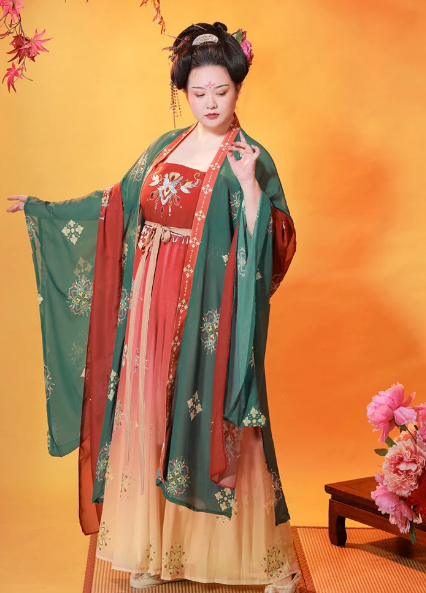
Hanfu Styles Across Different Periods and Regions
Hanfu, the traditional clothing of China, has evolved significantly over the years, showcasing a rich tapestry of styles influenced by different periods and regions. Let’s explore these diverse Hanfu styles:
Ancient Hanfu
Ancient Hanfu encompasses clothing styles from the earliest periods of Chinese history, characterized by simplicity and functionality:
- Design: Ancient Hanfu featured unadorned, loose-fitting garments designed for comfort and practicality.
- Materials: Clothing was primarily made from silk and hemp fabrics, reflecting the materials available at the time.
- Significance: Ancient Hanfu reflects the cultural values and lifestyle of early Chinese civilizations, with styles dating back to the Shang, Zhou, and Warring States periods.
Learn more about Ancient Hanfu
Han and Tang Dynasty Styles
Han and Tang Dynasty Styles represent a period of artistic flourishing, with clothing characterized by elegance and sophistication:
- Silhouettes: Clothing during these dynasties featured flowing lines, wide sleeves, and intricate embroidery.
- Influences: Han and Tang Dynasty styles were influenced by Central Asian and Silk Road cultures, resulting in unique designs.
- Cultural Legacy: These styles laid the foundation for later Hanfu fashion, influencing subsequent dynasties and regions.
Learn more about Han and Tang Dynasty Styles
Ming and Qing Dynasty Hanfu
Ming and Qing Dynasty Hanfu represents a more recent period in Chinese history, marked by distinctive fashion changes:
- Styles: Clothing during these dynasties featured more structured and layered designs, with specific garments for different occasions.
- Influences: Ming and Qing Dynasty Hanfu styles were influenced by Manchu and Mongolian cultures due to Qing Dynasty rule.
- Transition: These dynasties witnessed a shift in fashion from previous dynasties, with a mix of traditional and foreign elements.
Learn more about Ming and Qing Dynasty Hanfu
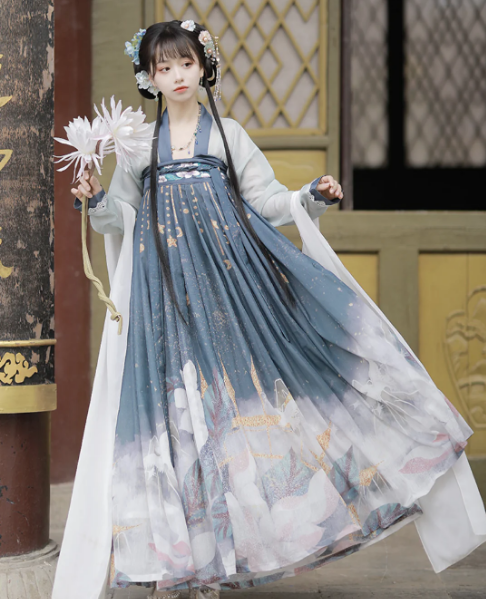
Regional Variations in Hanfu
Regional Variations in Hanfu showcase the diverse clothing styles across different regions of China:
- North vs. South: Northern Hanfu typically includes warm, layered garments, while Southern Hanfu features lighter, breathable fabrics.
- Ethnic Diversity: China’s vast geography has led to a wide range of regional styles influenced by various ethnic groups.
- Cultural Significance: These regional variations reflect not only climate but also the cultural diversity and heritage of different Chinese regions.
Learn more about Regional Variations in Hanfu
The evolution of Hanfu styles across different periods and regions reflects the rich cultural heritage and dynamic history of China. For further information, you can click on the provided Wikipedia links.







